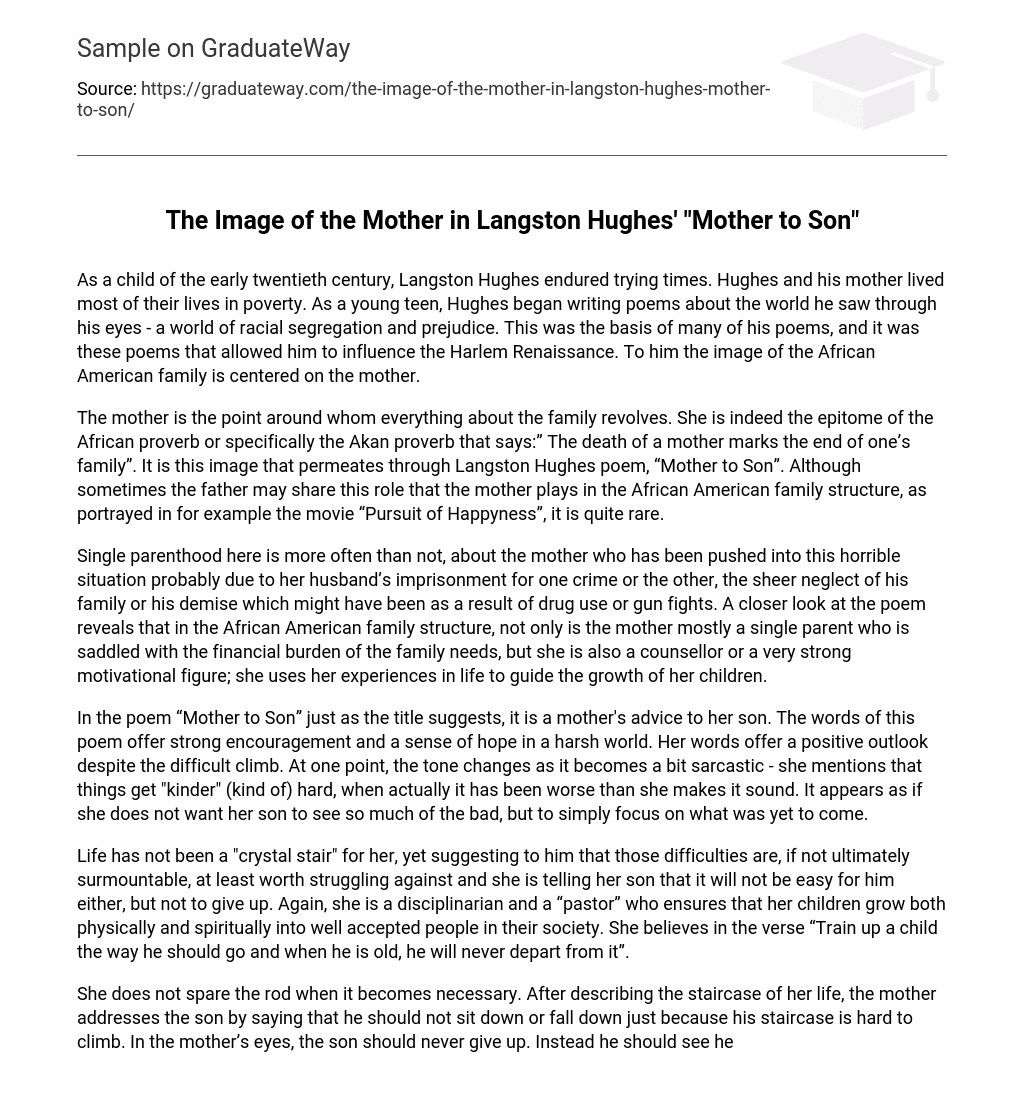As a child of the early twentieth century, Langston Hughes endured trying times. Hughes and his mother lived most of their lives in poverty. As a young teen, Hughes began writing poems about the world he saw through his eyes – a world of racial segregation and prejudice. This was the basis of many of his poems, and it was these poems that allowed him to influence the Harlem Renaissance. To him the image of the African American family is centered on the mother.
The mother is the point around whom everything about the family revolves. She is indeed the epitome of the African proverb or specifically the Akan proverb that says:” The death of a mother marks the end of one’s family”. It is this image that permeates through Langston Hughes poem, “Mother to Son”. Although sometimes the father may share this role that the mother plays in the African American family structure, as portrayed in for example the movie “Pursuit of Happyness”, it is quite rare.
Single parenthood here is more often than not, about the mother who has been pushed into this horrible situation probably due to her husband’s imprisonment for one crime or the other, the sheer neglect of his family or his demise which might have been as a result of drug use or gun fights. A closer look at the poem reveals that in the African American family structure, not only is the mother mostly a single parent who is saddled with the financial burden of the family needs, but she is also a counsellor or a very strong motivational figure; she uses her experiences in life to guide the growth of her children.
In the poem “Mother to Son” just as the title suggests, it is a mother’s advice to her son. The words of this poem offer strong encouragement and a sense of hope in a harsh world. Her words offer a positive outlook despite the difficult climb. At one point, the tone changes as it becomes a bit sarcastic – she mentions that things get “kinder” (kind of) hard, when actually it has been worse than she makes it sound. It appears as if she does not want her son to see so much of the bad, but to simply focus on what was yet to come.
Life has not been a “crystal stair” for her, yet suggesting to him that those difficulties are, if not ultimately surmountable, at least worth struggling against and she is telling her son that it will not be easy for him either, but not to give up. Again, she is a disciplinarian and a “pastor” who ensures that her children grow both physically and spiritually into well accepted people in their society. She believes in the verse “Train up a child the way he should go and when he is old, he will never depart from it”.
She does not spare the rod when it becomes necessary. After describing the staircase of her life, the mother addresses the son by saying that he should not sit down or fall down just because his staircase is hard to climb. In the mother’s eyes, the son should never give up. Instead he should see her as an example because it wasn’t easy for her, but she never gave up. In the poem she says: So boy, don’t you turn back. Don’t you set down on the steps ‘Cause you finds it’s kinder hard.
Don’t you fall now ____ For I’se still goin’, honey, I’se still climbin’, And life for me ain’t been no crystal stair The mother again is a teacher; she trains her children even to the point of career choice. At only twenty years of age, Hughes wrote the poem “Mother to Son”. The poet’s “mother,” who speaks in the voice of the African- American teaches him he need not abandon that tradition in order to write poetry. All poetry, she says, need not be about “crystal stairs.
” It can have “tacks” and “splinters” in it, “and places with no carpet on the floor. ” It need not conform to white conventions in either form or subject — it can be “bare”–yet it need not ignore those conventions if they can be of use (In fact, the line, “And life for me ain’t been no crystal stair” is written in iambic pentameter, the most traditional of English poetic meters). The poet discovers, from listening to his mother-muse, a way to bring the African-American experience into poetry.
He finds a way to move forward, to keep climbing. We can read in this poem, then, a kind of metaphor for the young poet’s artistic coming of age. From his “mother” he learns the value and power of his vocation. He hears in her song his own voice which is to serve as the source of inspiration or the starting point of his poetry career. Obviously, through his many literary works, Hughes sought to build up his community (family) of African-Americans by instilling in them a sense of pride and triumph.
This theme was frequently applied to his works as he wrote to encourage his readers to fight the battle against racism. In this poem as represented by the mother, he had hopes of somehow making a difference, a difference in which the world could change from its biased ways. One may be distracted by “tacks” and “splinters” such as racial discrimination and sometimes circumstances may appear “Bare” but he must “…been a-climbin’ on, And reachin’ landin’s, And turnin’ corners And sometimes goin’ in the dark Where there ain’t been no light.





